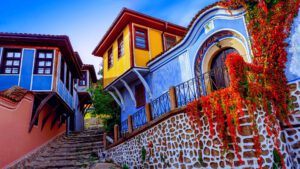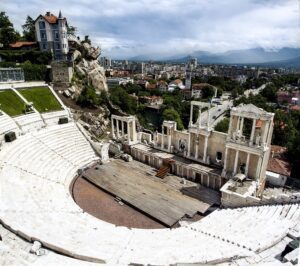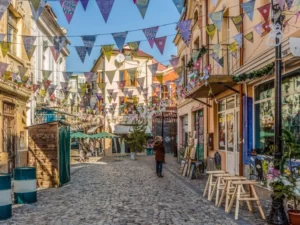
Plovdiv, Bulgaria: Known as Bulgaria’s ancient city built around seen hills, Plovdiv is one of the most beautiful cities in Europe and worldwide. The region has more than 3,000 years of history and architecture influenced by three continents; there’s nowhere else like it.
In 342 BC, King Philip II of Macedon (father of Alexander the Great) founded a city in modern-day Bulgaria and called it Philippopolis. He picked a naturally advantageous site, with seven steep hills (just like Rome) rising around the Maritsa River, all within view of the Rhodope Mountains to the south and the Balkans to the north.

There had already been a town in the area since 6,000 BC — it was also once ruled by Xerxes of Persia — and Plovdiv is still filled with ruins left by the ancient Thracians who lived in it for so long. But Philip established the first preeminent city there and settled a mix of Thracians, Macedonians, and Greeks within it.
Over the next two thousand years, Plovdiv (which has had many names) was fought over, captured, sacked, and rebuilt several times. Thracians, Macedonians, Persians, Romans (including Marcus Aurelius), Huns, Bulgars, Byzantines, Crusaders, Ottomans, and Russians have all fought over or found their way to this old, storied city.
And what has survived is an architectural and cultural delight. Plovdiv is scattered with ancient ruins, from the tumbled masonry of Thracian and Byzantine walls on Nebet Tepe (one of the seven hills, known as terpenes, from Turkish) to the Roman theatre — one of the most complete in Europe, which regularly hosts musical & theatrical performances — and the great stadium which once held 30,000 spectators.
Medieval fortifications have survived, too, such as the Hisar Kapia Gate. As with many Balkan cities, Plovdiv has places of worship belonging to Orthodox Christians, Catholics, Jews, Protestants, and Muslims. The Dzhumaya Mosque, built by the Ottomans when they conquered Plovdiv in the 14th century, is the oldest in Europe outside of Iberia.
Its Old Town, which stands on ancient and Medieval foundations, was further developed in the mid-19th century during the Bulgarian National Revival — as national consciousness awakened and the desire for independence from the Ottomans grew ever stronger — hence its profusion of traditional architecture.

Those timber-framed houses, with their jettied stories and projecting windows, are typical of Medieval Bulgarian architecture. The result is a labyrinth of brightly painted houses and churches built along the cobbled lanes of a Medieval street plan; all raised several hundred feet above the surrounding landscape on the three hills of Nebet Tepe, Dzhambaz Tepe, and Taksim Tepe.
The city was blessed with a new wave of architecture in the late 19th and early 20th centuries when Bulgaria revolted from the Ottomans and became an independent kingdom. Then, influenced by the Central European architecture of the Austro-Hungarian Empire, Plovdiv’s streets were filled with the colourful stucco and eclectic historicism of cities like Vienna.
Soon enough, a neighbourhood called “Kapana” emerged, the cultural and artistic heart of Plovdiv — which, to this day, is filled with artisans’ workshops, galleries, cafés, and exhibition spaces. After that came the USSR and a host of Communist-era edifices. In other words, this city has become an architectural palimpsest of the highest order.
Plovdiv is an aesthetic delight, a city of colour and shape, narrow alleys and shimmering squares, temples and fortresses, and a vibrant, living culture. It is also a prime example of architecture’s power to tell the whole story of a city.
Each street has thousands of years of war, religion, politics, cultural exchange, revolution, technological progress, and artistic evolution. This is one of the reasons architecture is so important; it’s like a language that brings the world to life. The buildings of Plovdiv are a physical story waiting to be read.

Plovdiv’s Old Town also speaks to the profound cultural significance of architecture. Those traditional houses were about reawakening Bulgarian identity after five centuries of enforced sleep under Ottoman rule. And this, if anything, is architecture’s most tremendous significance: that the way things are built and how they look matters to people, that buildings can manifest identity, meaning, place, and purpose.
Plovdiv is a beautiful city partly because of the unpredictable twists and turns of its history, caught as it was between the cultural and geopolitical cross-winds of countless different empires and peoples down the centuries — and partly by intention, because of how the people who live there have chosen to build and design their incredible city.
